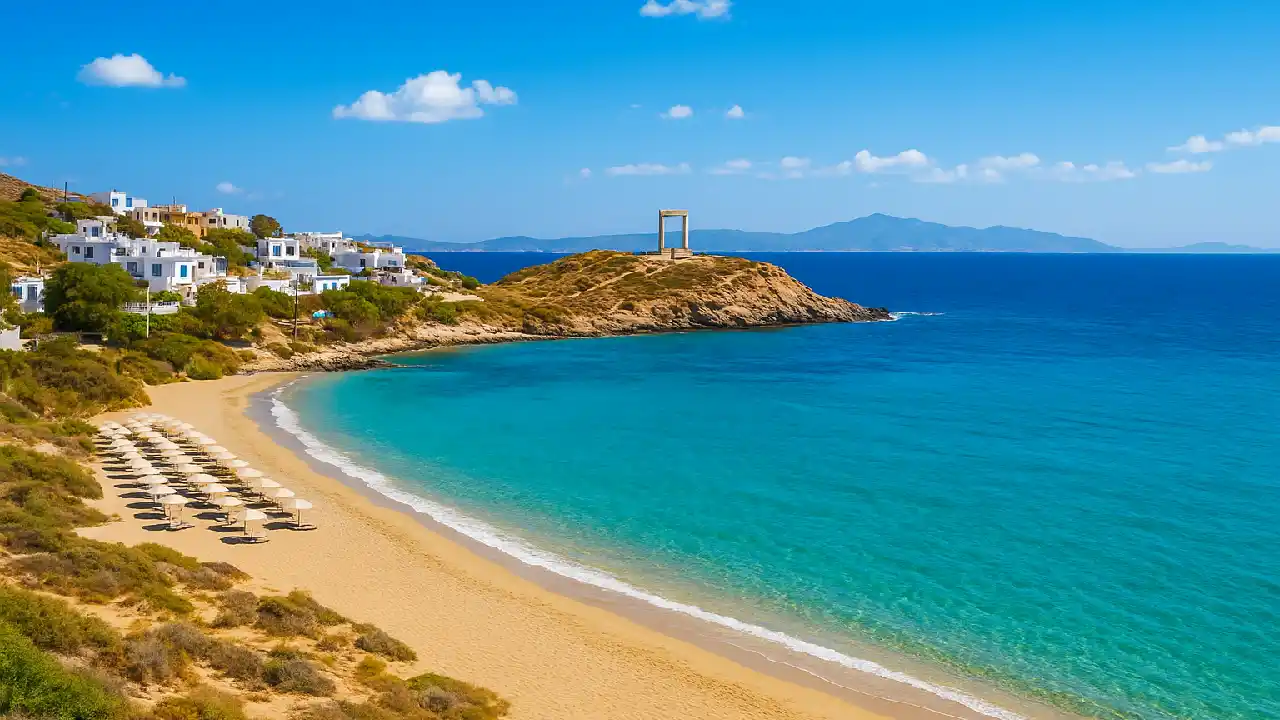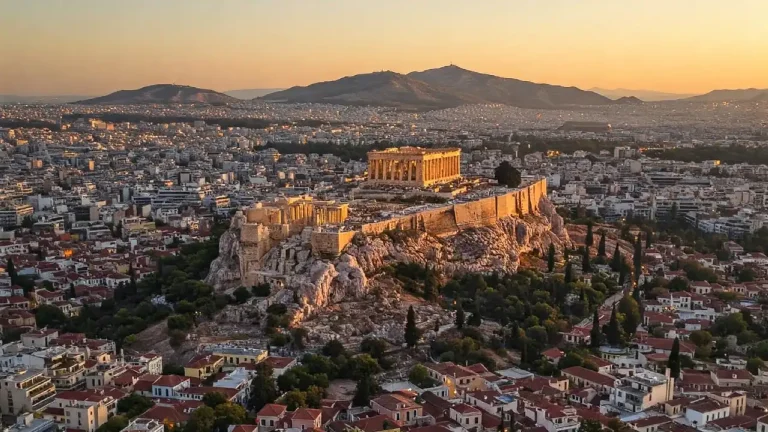Discover Naxos, Greece: Island, Beaches & Stays
Naxos, or Νάξος (the name in Greek), stands as the largest and most fertile of the Cyclades islands. With a blend of myth, history, lush inland landscapes, and some of Greece’s best beaches, Naxos island Greece offers something for travelers seeking more than a postcard view. In this guide, we’ll dive deep: from getting there and exploring Chora, to the famed naxos agios prokopios coastline, and ultimately choosing the right naxos hotels for your stay.
Naxos in Greek and a Brief Introduction
The Greek name Νάξος (pronounced “Náxos”) hints at the island’s long heritage in Hellenic culture. Over centuries, Naxos has witnessed ancient Greek, Roman, Byzantine, Venetian and Ottoman influence, each layering a story onto its landscape. Today, the island is vibrant: agriculture, local arts, traditions, and tourism knit together to bring visitors a rich experience.
Though part of the Cyclades, Naxos feels more self-sufficient than many other Greek isles. Thanks to its fertile plains, olive groves, vineyards, and water sources, locals often pride it as more “complete” than islands that depend solely on imports. The island’s interior, with winding roads, mountain villages, and scenic valleys, contrasts beautifully with its coastline of silky sand beaches and shimmering Aegean waters.
How to Get There & Getting Around
By Ferry or Air
Naxos is accessible by ferry from Athens (Piraeus and Rafina) and from many Cycladic islands. Depending on the vessel (conventional ferry vs. high-speed), travel time can range from 3 to 6 hours. During summer, there are multiple daily connections.
The island also has a small airport with flights from Athens, especially during the tourist season, making it convenient for shorter trips.
On the Island: Transport Options
Once on Naxos, you can rent a car or scooter to explore the interior and remote beaches. Buses (KTEL / local lines) connect Chora to major beaches and villages. For example, Agios Prokopios is served by local bus routes.
Taxis and private transfers are also available, though less common outside main hubs. If you plan to visit many inland mountain villages, a private vehicle or tour is more flexible.
Naxos Town (Chora): Heart of the Island
Chora, or Naxos Town, is the island’s capital and first impression for many visitors. With its Venetian castle (Kastro), winding alleys, neoclassical mansions, and the iconic Portara (the marble gate of the unfinished Temple of Apollo), it’s a place that rewards slow wandering. At sunset, the Portara frames the sea in gold, a favorite moment for photographers.
Around Chora are shops, cafés, tavernas, museums (like the Archaeological Museum), and waterfront promenades. Staying here places you a short walk from both town life and nearby beaches.
Beaches and Coasts
Naxos is famous for its long sandy beaches, many of which are easily reachable from Chora. The western coast tends to host the most visited stretches.
Agios Prokopios
Perhaps the island’s signature beach, Agios Prokopios is a golden-sand stretch, approximately 1.5 km long, with crystal-clear waters and good protection from strong northern winds.
It has an organized side (with sunbeds, umbrellas, beach bars) and a more natural side near the chapel along the northern edge.
It’s about 5 km from Chora and is on regular bus routes between Chora and nearby beaches like Plaka and Agia Anna.
Many travelers regard it as among the island’s best beaches.Because of its popularity, in high season parts may feel busy, but it retains beauty and convenience.
Other Beaches to Explore
- Plaka / Agia Anna: Extend the coastline from Agios Prokopios, with quieter vibes and scenic sands.
- Mikri Vigla: Known for strong winds, it is a hotspot for windsurfing and kiteboarding.
- Aliko, Orkos, Pyrgaki: More remote and tranquil options for beach lovers.
Each beach has its own charm and character depending on ambiance, services, and exposure to wind.
What to See & Do Beyond the Beach
Mountain Villages and Inland Beauty
Venture inland to encounter traditional villages such as Filoti, Apeiranthos, Halki, and Koronos. In these places, time seems to slow — stone pathways, local crafts, and friendly tavernas await. The valleys and foothills offer pleasant hiking and scenic drives.
Archaeology & History
Beyond the Portara, visit the Temple of Demeter, remnants of ancient fortifications, and scattered ruins. The Venetian influence remains strong in the architecture of Chora and some inland villages.
Outdoor Activities
Hiking trails, coastal loops (for instance around Agios Prokopios chapel and cape) offer walking routes of varying difficulty.
Water sports like snorkeling, windsurfing, kiteboarding are popular at certain shores.
Local tours — cooking, olive oil tasting, boat trips to nearby islets — often add cultural depth.
Naxos Hotels: Where to Stay
Whether you prefer luxury or simplicity, Naxos offers a broad range of accommodations.
In Chora / Central Area
Many boutique and mid-size hotels cluster near the waterfront or inside the old town. For example, Anapollo Boutique Hotel in Chora is praised for its charm and central location.
Hotel Grotta, Adriani, and Hotel Anixis are other options close to the heart of Chora.
Near Beaches & Coastal Zones
If your priority is beach access, many naxos hotels are located near or within walking distance of beaches like Agios Prokopios, Plaka, Agia Anna.
Agios Prokopios Hotel lies just a couple of minutes’ walk from the sandy beach; it features a pool, garden, and breakfast services.
Other choices include seaside boutique resorts and luxury stays such as Villa Marandi Luxury Suites, Naxos Resort Beach Hotel, and properties by Marriott Bonvoy.
Boutique & Luxury
Small Luxury Hotels (SLH) lists boutique stays in Naxos, emphasizing local style and exclusivity.
Sundunes Hotel in Plaka is a newly rising property combining modern design and luxury by the sea.
Focusing on Naxos Agios Prokopios
Because naxos agios prokopios is such a highlight, let’s zoom in deeper on what makes it special and how to maximize your visit.
Why Agios Prokopios Is Special
Its long, gently sloping sand with calm water makes it ideal for families and swimmers.
The beach’s mix of organized and natural parts gives visitors flexibility to choose comfort or a more rustic feel.
Because of its scenic quality and popularity, it’s frequently rated among Greece’s top beaches.
Visiting Tips & Logistics
- Go early in the day or later in the afternoon to avoid peak crowds.
- Bring sunscreen, water, hat — shade can fill up in prime spots.
- If comfortable, explore the less-organized northern end near the chapel for quieter stretches.
- For a stroll: the “Agios Prokopios beach, chapel and cape Loop” trail (about 1–1.5 h) provides scenic views.
Dining & Amenities
In the area around Agios Prokopios, you’ll find tavernas, beach bars, snack spots, and local eateries — for example, Giannoulis Taverna and others.
Because it’s a major beach zone, support services (restrooms, showers, sunbed rentals) are well established, especially closer to the organized side.
Accommodation Near Agios Prokopios
If staying nearby, the aforementioned Agios Prokopios Hotel is convenient.
You can also find other beachside or near-beach hotels that combine ease of access with comfort. Choosing a hotel here means your beach is your backyard.
Sample Itinerary Ideas
| Duration | Highlights |
|---|---|
| 3 days | Day 1: Arrive, stroll Chora, visit Portara at sunset Day 2: Beach day at Agios Prokopios or Plaka Day 3: Half day inland visit to a village, depart |
| 5 days | Add a day for exploring villages (Filoti, Apeiranthos) and an excursion to remote beaches Another day for water sports or boat trip |
| 7+ days | Relaxed pace: repeat favorite beaches, sample local culinary tours, slow drives, photography, hidden coves |
This plan lets you balance beach time, culture, and quiet exploration.
Best Time to Visit & Weather Considerations
The prime season runs from late May through early October, when heat, sunshine, and sea conditions are ideal. Shoulder months (May, September) offer milder crowds and pleasant weather.
In summer, the Meltemi (northern wind) can be strong, especially July–August, affecting some beaches. Agios Prokopios is somewhat sheltered but still may feel breezy.
Outside summer, many hotels scale back operations, but the landscape remains beautiful and peaceful.
Tips & Practical Advice
- Book early for hotels: especially if you want beachfront or boutique options in summer.
- Use local buses: for beaches, but check schedules (they change in off-peak times).
- Pack light, smart: beach gear, sun protection, good walking shoes for inland trails.
- Respect local norms: in small villages, dress modestly at churches, be mindful of noise in quiet zones.
- Try local food & produce: Naxos has excellent cheeses, potatoes, olive oil, local wine.
- Stay hydrated: especially when walking inland or in heat.
Frequently Asked Questions
What is Naxos called in Greek?
Naxos in Greek is Νάξος (pronounced Náxos).
How far is Agios Prokopios from Naxos Town?
Approximately 5 km, reachable by local buses or a short drive.
Which beaches are best for windsurfing on Naxos?
Mikri Vigla is known for its windy conditions and is a top choice for windsurfing and kiteboarding.
Also, some parts of Plaka and Orkos may offer conditions for water sports depending on wind and sea state.
Are there luxury hotels in Naxos?
Yes. Luxury and boutique hotels exist, such as Sundunes in Plaka, Villa Marandi Luxury Suites, and other properties affiliated with boutique or small luxury hotels associations.
Is Agios Prokopios good for families?
Yes. Its gradual sand slope and calm waters, plus available amenities, make it family-friendly.
What can I do inland on Naxos besides beaches?
Visit mountain villages, hike scenic paths, taste local foods, explore ruins and churches, take photogenic drives, and enjoy local culture away from the coast.
Conclusion
Naxos is a compelling mix of Aegean magic: from the bright blue seas of naxos agios prokopios, to the narrow alleys of Chora, to the quiet mountain villages and fertile valleys. It offers the kind of Greek island experience that balances relaxation, cultural depth, natural beauty, and local flavor. Choosing naxos hotels wisely can enhance your stay: whether seaside or in town, comfort and accessibility matter.
Outbound Links
Naxos Official Tourism Site – The island’s official tourism website
Visit Greece (Official) – The official tourism portal of Greece








